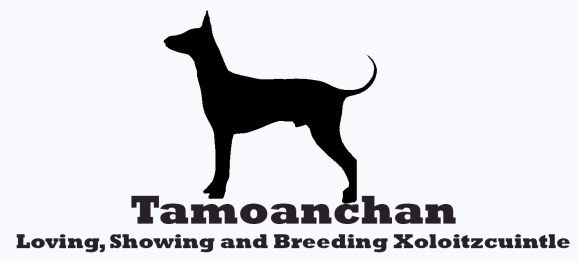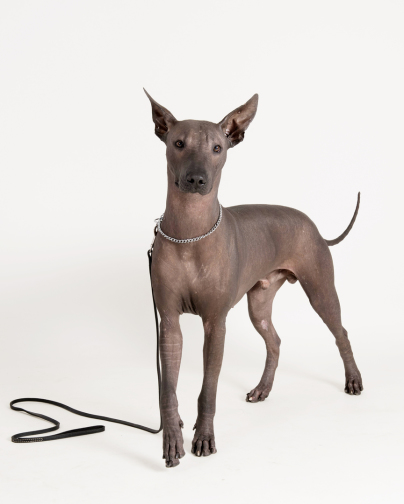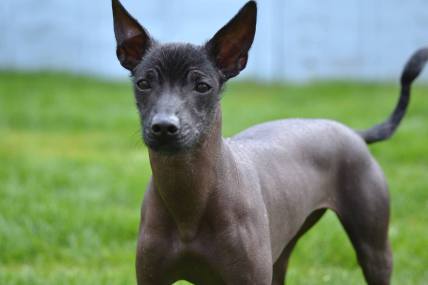Xoloitzcuintle-(Mexican Hairless)
The Xoloitzcuintle (or Xoloitzcuintli - pronounced zoh-loh-eets-KWEENT-lee), Xolo for short, is a hairless breed of dog, found in miniature (or toy), intermediate, and standard sizes. It is also known as the Mexican hairless dog in English-speaking countries, and is one of several breeds of hairless dog.
The name xōlōitzcuintli comes from the god Xolotl and itzcuīntli meaning dog in Nahuatl.
The breed ranges in size from about 10 to 50 lb (4 to 20 kg). Similar in appearance to a Pharaoh Hound, with a sleek body, almond-shaped eyes, large bat-like ears, and a long neck, the Xolo is notable for its dominant trait of hairlessness. The dominant hairless trait originated in this breed as a spontaneous mutation thousands of years ago. The recessive expression of the trait will produce a coated variety, which is genetically inseparable from the hairless, as the homozygous appearance of the hairless mutation is fatal to the unborn pup. Most litters contain both hairless and coated puppies. The coated variety, covered with a short, flat dense coat represents the original form of the dog, prior to the occurrence of the spontaneous hairless mutation. The hairless variety is completely hairless on the body, with many dogs exhibiting a few short hairs on the top of the head, the toes, and the tip of the tail. Most hairless dogs are black or bluish-gray in color. The allele responsible for the Xolo's hairlessness also affects the dog's dentition: Hairless Xolos typically have an incomplete set of teeth while the dogs of the coated variety have complete dentition.
The Xolo is moderate in all aspects of its appearance, conveying an impression of strength, agility, and elegance. Xolo body proportions are rectangular, slightly longer in total body length than the height measured at the highest point of the withers (top of the shoulders). Hairless Xolos are the dominant expression of the heterozygous hairless trait. Coated Xolos are the recessive expression, and breeding hairless to coated or hairless to hairless may produce pups of either or both varieties. Breeding coated to coated will only produce coated pups because they are recessive to the hairless trait and do not carry the dominant H gene.
Both varieties occur in all hair or skin colors, and often marked, splashed, or spotted. The most common colors are various shades termed black, blue, and red.
Temperament
The Xoloitzcuintli's 'primitive' temperament (very high intelligence, sensitivity, high energy, inquisitiveness, strong hunting, and social instincts) is apparent because the breed's temperament was not modified overall by selective breeding in their native history in Mexico. This has also ensured a sturdy physical nature and vigorous health generally innate in both coated and uncoated Xolos. Adult Xolos are frequently noted for their calm demeanor, although puppies can be extremely energetic, noisy, and very oral until they reach maturity (after 2 years old), after which they tend to settle down and become more calm. Inadequately supervised or exercised Xolos can become escape artists, climbing and jumping fences to chase. Many individuals of this breed can possess guard dog ability and will not back down from a fight. At the same time, adult dogs, when they are raised properly, can become steady, well-behaved, and affectionate companions.
Though physically grown at one year, many dog breeds including Xolos, are not 'emotionally mature' until around two years. Like active breeds such as terriers, Xolos need calm, consistent, and loving obedience training and regular socialization during their growing years. Well-raised Xolos bond strongly with their owners, becoming highly devoted to their families while frequently choosing one specific family member as favorite.
Anyone considering acquiring a Xolo should expect to spend time educating themselves in positive dog training techniques, and, ideally, should have prior experience with active and intelligent dog breeds. A spacious, well-fenced, and safe physical environment is desirable for this breed. Daily walks are ideal for exercising most toy-sized Xolos, however more stimulating physical and mental exercise is advised for larger and more active individuals. Behavior problems in Xolos are typically a result of a dog receiving inadequate or inconsistent supervision, as well as inadequate exercise and mental stimulation. The Xoloitzcuintli is a social dog that should not, in most cases, be an "only dog". It does not do well when kept as an outside-only dog. This is a breed that is at its best when it is made part of the family, receiving regular interaction and socialization with its humans (and other dogs, whether present in the home or as regular playmates).
Health
The Xolo has been developed by natural selection for thousands of years, and is therefore generally not prone to health and structure problems as other dog breeds more modified by human selection efforts. Xolos came from tropical climates and are not typically suited for outdoor life in colder temperate and northern climates unless they are well protected from the extremes of the weather. They need bathing, light grooming, and skin care as with other dogs of similar physical type, or acne can result. Most skin problems arise from poor breeding, neglect, or over-bathing and over-lotioning, stripping natural protections and clogging pores.



